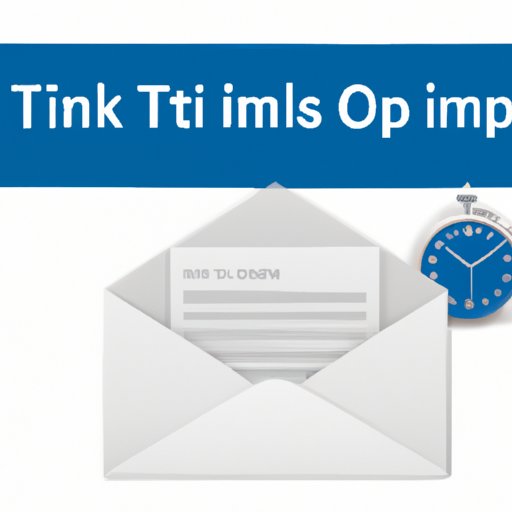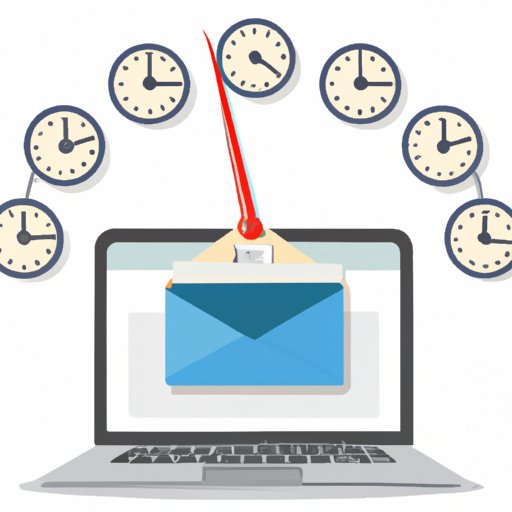Introduction
Do you struggle with keeping up with your email inbox? Are you constantly sending emails in the middle of the night or on weekends because you don’t have time during the day? If you use Outlook as your email platform, you may be surprised to learn that you can actually schedule emails in advance. This feature can save you time, help you be more productive, and enhance communication with your colleagues. In this article, we will guide you through the steps of scheduling an email in Outlook, discuss the advantages and benefits of this feature, and provide tips and tricks to optimize the process.
A Step-by-Step Guide to Schedule an Email in Outlook
Scheduling an email in Outlook is simple and straightforward. Follow these easy steps to schedule your next email:
1. Open a new email message.
2. Click on the Options tab in the ribbon.
3. Click on Delay Delivery in the More Options group.
4. In the Properties dialog box, select the checkbox next to Do not deliver before, and then select the date and time that you want the email to be sent.
5. Click Close
6. Finish composing and sending your email as usual.
How to Be More Productive with Outlook by Scheduling Emails
By scheduling emails in Outlook, you can save time and energy by planning ahead. Here are some examples of when scheduling emails can be particularly useful for productivity:
– When you need to send a reminder or follow-up email but don’t want to interrupt someone’s workday
– When you work on evenings or weekends but want to avoid sending messages outside of business hours
– When you want to send multiple emails over time but don’t want to clutter someone’s inbox with too many messages at once.
The Benefits of Scheduling Emails on Outlook
Scheduling emails in Outlook can provide a host of benefits, including better time management, enhanced organization, and improved efficiency. Here are some examples of how scheduling emails can improve your work:
– You can prioritize your workload by sending important emails first and scheduling less important ones later.
– You can organize your inbox by scheduling emails to be sent on a specific date or time.
– You can reduce stress and increase productivity by avoiding constant email interruptions throughout the day.

Tips and Tricks for Scheduling Emails in Outlook
To make the most of scheduling emails in Outlook, try these helpful tips:
– Double-check the date and time before scheduling your email to avoid mistakes.
– Consider the time zone of your recipients to ensure that your email arrives at a convenient time for them.
– Use templates or drafts to streamline the process and save time.
– Set reminders for yourself to follow up on important emails before or after they are sent.
Outlook vs. Other Email Platforms: The Advantages of Scheduling Emails
While many email platforms offer the ability to schedule emails, Outlook stands out for its unique features and functionalities. For example, Outlook allows you to set up rules and conditions for scheduling emails, such as only sending them to specific recipients or at certain times of the day. Additionally, Outlook integrates seamlessly with Microsoft Office Suite, making it easy to integrate and manage other Microsoft applications.
How Scheduling Emails in Outlook Can Improve Communication with Colleagues
Communication and collaboration are essential to a productive work environment, and scheduling emails can help to enhance both. With scheduled emails, you can make sure that everyone on your team is on the same page and that expectations are clear. Here are some examples of situations where scheduling emails can improve communication:
– When working across different time zones, to ensure everyone receives messages at a convenient time.
– When sending important updates or meeting requests, to avoid conflicting schedules.
– When sending recurring messages, such as weekly progress reports or team updates, to ensure consistency and reliability.
Best Practices for Scheduling Emails in Outlook and Avoiding Mistakes
To make the most of scheduling emails in Outlook, here are some best practices and common mistakes to avoid:
Best practices:
– Plan ahead and schedule your emails in advance to prioritize your workload and avoid constant email interruptions.
– Test your scheduled emails before sending them to ensure that they arrive on time and are error-free.
– Use templates and drafts to streamline the process and save time.
– Keep track of your scheduled emails and any follow-up tasks using Outlook’s task manager.
Mistakes to avoid:
– Sending emails to the wrong recipients or at the wrong time zone.
– Forgetting to schedule an important email and missing a deadline.
– Overloading someone’s inbox by sending too many emails at once.
– Not following up on scheduled emails or forgetting to cancel them if they are no longer necessary.
Conclusion
Scheduling emails in Outlook is a valuable tool that can enhance productivity, organization, and communication in your work environment. By following the steps outlined in this article and using best practices, you can optimize the process and avoid common mistakes. We encourage you to give it a try and share your feedback or questions in the comments. With a little planning and organization, you can take control of your email inbox and make the most of your workday.
